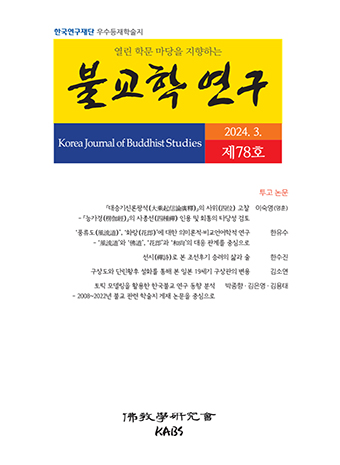Abstract
References
Sorry, not available.
Click the PDF button.
Information
Mahāyānasaṅgraha is the key text of Indian Mahayana Buddhism and the Shèlùnzōng (攝論宗, the sect of Mahāyānasaṅgraha) in the period of Wèijìn- Nánběicháo (魏晉南北朝, the Wei, Jin, Southern and Northern Dynasties, AD. 256-589) which was a formative period of Chinese Buddhism. The original Sanskrit text does not remain intact, and a Tibetan translation and four Chinese translations remain now. This study considers Zhēndì’s (眞諦, Paramārtha, AD. 499-569) translation as a key text and compares it with Xuánzàng’s (玄奘) translation and Fótuóshànduō’s(佛陀扇多, Buddhaśānta) one about the relation of the Bīja theory (種子說) of the Ālayavijñāna. Because the key aim of Mahāyānasaṅgraha is the enhancement of Mahayana, this study considers firstly the Mahayana view of Asaṅga (無着) that appeared in his biography. Second, this study analyzes the system of Mahāyānasaṅgraha which divides key doctrines as ten ways, and considers several arguments about the Ālayavijñāna in Yīngzhīsuǒzhīfēn (應知依止分), which is the first chapter of Mahāyānasaṅgraha. After analyzing, we can find that the outer bīja theory (外種子說) is explained in Xiàngpǐn (相品, the part of the form) and Chābiépǐn (差別品, the part of the differentiation) in Yīngzhīsuǒzhīfēn. The bīja is explained as the patitya samutpāda (緣起) of the discrimination of the self (自性分別), and the discrimination (分別性) as the simultaneity of the inner and the outer (內外同時性) by the quotations from Madhyāntavibhāga (辯中邊論頌) in Xiàngpǐn. The differentiation (差別) of the Ālayavijñāna is explained by three and four kinds of ways in the differentiation of appearance (相貌) in Chābiépǐn. Asaṅga divides the bīja as sāmāy-lakṣaṇa (共相)/ aṣmāy-lakṣṇa(不共相) of internal-external dimension, janma(受生)/ ajanma(無受生), and the bija in ādhyātmika-āyantana(內入處)/ bhājana-loka(器世間), and proves that the Ālayavijñāna can exist only when there is the outer condition(外緣). The implication of this proof is that outer world which exists as sāmāy-lakṣaṇa is synchronistic with the inner bīja(內種子) made by ādhyātmika-āyantana, and is the outside of the discrimination of the Ālayavijñāna. This also belongs to the dharma side of discrimination, which has two sides, atman and dharma. Mahāyānasaṅgraha explains the cause which makes the world as the bīja, and stresses six meanings of the bīja. However, these are limited to the inner bīja, and the outer condition of the discrimination is the bhājana-loka bīja(器世間種子) as the common bīja(共種子) made by the common karma(共業). The bīja of the inner conditions is the inner bīja hidden in the Ālayavijñāna, which makes the effect as a result, and is stored(薰習) in the Ālayavijñāna as a habit. But the outer bīja(外種子) doesn’t have the function of being stored and the action of feeling, and it is just as limitless as the bhājana-loka. Mahāyānasaṅgraha says that the relation between the inner bīja and the outer bīja are not of order, but the cause of each. When mind cures defilements, the target of the curing is limited to the inner bīja, and the outer bīja is manifested as the object which should be cured. The outer bīja of Asaṅga means that infinite outer environments like the natural one unites with mind and relates with true self, representing Mahayana which unites the world of sentient beings to one mind. We can understand that the outer bīja theory of Asaṅga proves that the relation between mind and outer objects (dharma) is inseparable.
섭대승론은 인도대승불교를 대표하는 문헌이자, 중국불교 형성기라고 할 수 있는 위진남북조시대의 섭론종을 낳은 핵심 논서이다. 산스크리트어 원전은 부분적으로 환범할 수 있는 상태이며, 티베트어역과 4종의 한역이 현존한다. 본 연구는 4종의 한역 중 진제역을 중심으로 현장과 불타선다역을 비교하여 아뢰야식 종자설의 내외관계를 밝혔다. 섭대승론은 대승선양이 논 전개의 핵심 목적이기 때문에, 먼저 전기(傳記)에 나타난 무착의 대승적 입장을 살펴보았다. 다음으로 대승의 핵심 교의를 10가지로 체계화한 섭대승론의 구성을 살펴보았으며, 첫 번째 장에 해당하는 응지의지분(應知所知分)의 아뢰야식에 대한 다양한 논의를 분석하였다. 분석한 결과 외종자설은 섭대승론의 응지의지분의 상품(相품)과 차별품(差別品)에서 기술되고 있었다. 상품은 종자를 연기의 두 가지 중 자성분별의 연기도리로 설명하고, 분별성은 내외 동시성이라고 하며, 이를 변중변론송을 인용하여 논증하고 있었다. 차별품은 아뢰야식의 차별을 3가지와 4가지로 설명하는데, 상모(相貌)의 차별에서 기술되고 있었다. 무착은 아뢰야식의 차별을 설명하는 내용 가운데에 종자를 내외의 공상(共相)과 불공상(不共相)으로 나누고, 무수생(無受生), 수생(受生)으로 나누고, 내입처와 기세간의 종자로 나누어 아뢰야식은 외연(外緣)이 있어야만 가능함을 논증하였다. 이 논증 속의 의미는 공상으로 존재하는 외부 세계는 내입처(內入處)에 의해서 만들어지는 내종자와 동시성으로 아뢰야식의 분별의 외부를 담당한다는 것이다. 이는 분별에 양 측면 아(我)와 법(法) 중 법에 해당한다고 볼 수 있다. 섭대승론은 모든 존재 현상을 낳는 원인의 씨앗을 ‘종자’라고 하고, 6가지 속성적 의미를 담고 있다고 종자의 6의(義)를 유식논의에 전격적으로 부각시킨다. 이는 내종자에 국한된 것이며, 분별의 외연은 공업에 의해 만들어진 공종자로서의 기세간종자의 모습인 것이다. 아뢰야식에 감추어져 있는 내연(內緣)의 종자를 내종자(內種子)라고 하는 것이며, 내종자란 원인을 통한 결과적 작용을 낳고 일종의 습관처럼 아뢰야식 내에 훈습되는 것이라고 한다. 이에 반해 외종자는 훈습의 기능은 없고 감수작용이 없으며, 끝없이 펼쳐지는 기세간이라고 한다. 특히 섭대승론은 내외의 종자는 서로간의 인(因)이 된다고 하고, 선후관계는 아니라고 한다. 마음이 번뇌를 대치할 때 내종자에 국한하며, 외종자는 소대치(所對治)의 작용을 한다고 한다. 무착의 외종자설은 외연에 자리 잡고 있는 자연환경 등 무한한 외부환경이 마음에 결합함을 의미하며, 진여와 관계하고, 중생세계를 일심(一心)으로 합일하는 대승을 의미한다. 다시 말해 심(心)은 외부대상[法]과 불가분의 관계임을 논증하는 것이라고 할 수 있다.
Click the PDF button.
- Publisher :Korean Association of Buddhist Studies
- Publisher(Ko) :불교학연구회
- Journal Title :Korea Journal of Buddhist Studies
- Journal Title(Ko) :불교학연구
- Volume : 45
- No :0
- Pages :33~58


 Korea Journal of Buddhist Studies
Korea Journal of Buddhist Studies






